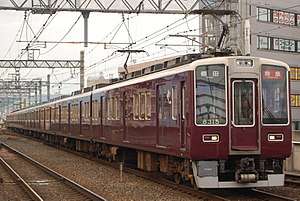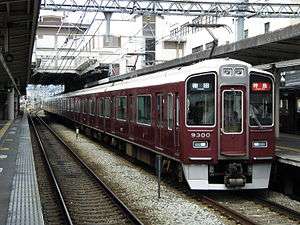Hankyu 8300 series
The Hankyu 8300 series (阪急電鉄8300系) is an electric multiple unit (EMU) train type operated in Japan by the private railway operator Hankyu Railway since 1989.[2]
| Hankyu 8300 series | |
|---|---|
 8-car set 8315 on a limited-express service, July 2017 | |
| In service | 1989– |
| Manufacturer | Alna Kōki |
| Number built | 84 vehicles (15 sets) |
| Number in service | 84 vehicles (15 sets) |
| Formation | 2/6/8 cars per trainset |
| Operator(s) | Hankyu Railway |
| Depot(s) | Katsura |
| Line(s) served | Hankyu Kyoto Main Line Hankyu Senri Line Hankyu Arashiyama Line Osaka Metro Sakaisuji Line |
| Specifications | |
| Car body construction | Aluminium alloy |
| Car length | 18,900 mm (62 ft 0 in) |
| Width | 2,850 mm (9 ft 4 in) |
| Height | 4,095 mm (13 ft 5.2 in) |
| Doors | 3 pairs per side |
| Maximum speed | 115 km/h (70 mph) |
| Traction system | Variable frequency (GTO) |
| Power output | 170 kW (230 hp) per motor[1] |
| Electric system(s) | 1,500 V DC overhead catenary |
| Current collection method | Pantograph |
| Bogies | FS-369A, FS-069A SS-139A, SS-039A |
| Braking system(s) | Regenerative brake Electronically controlled pneumatic brakes |
| Safety system(s) | ATS, ATC |
| Coupling system | Shibata-type |
| Multiple working | 7300 series |
| Track gauge | 1,435 mm (4 ft 8 1⁄2 in) |
Formations
As of 1 April 2012, the fleet consists of 84 vehicles formed as five 8-car sets, four 6+2-car sets, and two 6-car sets which normally run coupled with 2-car 7300 series sets.[3]
8-car sets
| Car No. | 1 | 2 | 3 | 4 | 5 | 6 | 7 | 8 |
|---|---|---|---|---|---|---|---|---|
| Designation | Mc1 | M2 | T1 | T2 | T2 | T1 | M1 | Mc2 |
| Type | Mc8300 | M8900 | T8850 | T8950 | T8950 | T8850 | M8800 | Mc8400 |
| Numbering | 8300 | 8900 | 8850 | 8950 | 8980 | 8870 | 8800 | 8400 |
2+6-car sets
| Car No. | 1 | 2 | 3 | 4 | 5 | 6 | 7 | 8 | |
|---|---|---|---|---|---|---|---|---|---|
| Designation | Mc1 | Tc | Mc1 | T1 | T2 | T1 | M1 | Mc2 | |
| Type | Mc8300 | Tc8450 | Mc8300 | T8850 | T8950 | T8850 | M8800 | Mc8400 | |
| Numbering | 8330 | 8450 | 8300 | 8850 | 8950 | 8870 | 8800 | 8400 |
- The "Mc1" and "M1" cars are each fitted with two scissors-type pantographs.[3]
2+6-car mixed 7300/8300 series sets
| Car No. | 1 | 2 | 3 | 4 | 5 | 6 | 7 | 8 | |
|---|---|---|---|---|---|---|---|---|---|
| Designation | Mc | Tc | Mc1 | T1 | T2 | T1 | M1 | Mc2 | |
| Type | 7300 | 7450 | Mc8300 | T8850 | T8950 | T8850 | M8800 | Mc8400 | |
| Numbering | 7300 | 7450 | 8300 | 8850 | 8950 | 8870 | 8800 | 8400 |
- The "Mc", "Mc1", and "M1" cars are each fitted with two scissors-type pantographs.[3]
 8300 series in original style before 1995
8300 series in original style before 1995 8300 series second build train, April 2020
8300 series second build train, April 2020- 8-car set 8315 with single-arm pantographs, October 2008
 Set 8330 leading a 2+6-car formation, July 2006
Set 8330 leading a 2+6-car formation, July 2006 Set 8300 "classic 8300" livery, January 2020
Set 8300 "classic 8300" livery, January 2020
Interior
Passenger accommodation consists of longitudinal bench seating throughout.[2]
gollark: * server
gollark: Is there some way I can move my number between two channels on a serber?
gollark: Thanks!
gollark: I'm trying to beat my previous 320 hour call record.
gollark: The way it keeps telling me to hang up calls is very irritating.
References
- Harris, Ken, ed. (2005). Jane's World Railways 2005-2006 (47th ed.). Jane's Information Group. p. 291. ISBN 0 7106 2710 6.
- 私鉄車両年鑑2012 [Japan Private Railways Annual 2012]. Tokyo, Japan: Ikaros Publications Ltd. February 2012. p. 72. ISBN 978-4-86320-549-9.
- 私鉄車両編成表 2012 [Private Railway Rolling Stock Formations - 2012]. Japan: JRR. July 2012. p. 140. ISBN 978-4-330-29911-2.
| Wikimedia Commons has media related to Hankyu 8300 series. |
This article is issued from Wikipedia. The text is licensed under Creative Commons - Attribution - Sharealike. Additional terms may apply for the media files.
